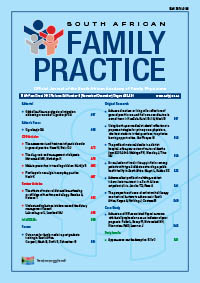The perspectives of users of antiretroviral therapy on structural barriers to adherence in South Africa
Keywords:
Adherence, Antiretroviral therapy, Structural barriers
Abstract
Background: The effectiveness of antiretroviral therapy (ART) and the importance of adherence to treatment regimens are widely known. Yet, suboptimal adherence to ART and retention in care of patients still persists and, by many accounts, is fairly widespread. The aim of this study was to identify the structural barriers that influenced adherence among patients who were enrolled in the national ART programme in South Africa. Method: In this qualitative study, semi-structured interviews were conducted with a sample of 10 patients receiving ART at a public hospital in South Africa. Results: The results of the interviews were categorised according to poverty-related, institution-related and social barriers to clinic attendance and pill-taking, which collectively formed the structural barriers to adherence. The chief structural barriers to clinic attendance were time away from work, transport expenses, long waiting times and negative experiences with clinic staff. The chief barriers to pill-taking were food insecurity, stigma and discrimination. Conclusion: The barriers to adherence are discussed. Attention is called to the extraindividual factors that influenced ART adherence. We conclude that contextual factors, such as a healthcare-enabling environment, might play an important role in influencing healthcare-promoting behaviour among patients.
Published
2012-07-30
Section
Original Research
By submitting manuscripts to SAFP, authors of original articles are assigning copyright to the South African Academy of Family Physicians. Copyright of review articles are assigned to the Publisher, Medpharm Publications (Pty) Ltd, unless otherwise specified. Authors may use their own work after publication without written permission, provided they acknowledge the original source. Individuals and academic institutions may freely copy and distribute articles published in SAFP for educational and research purposes without obtaining permission.

